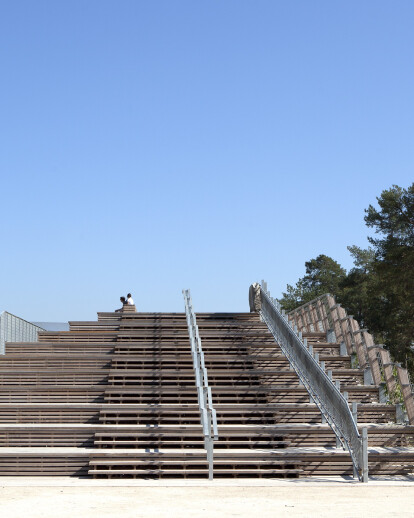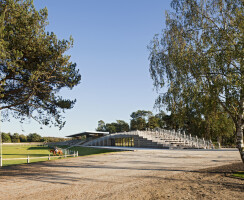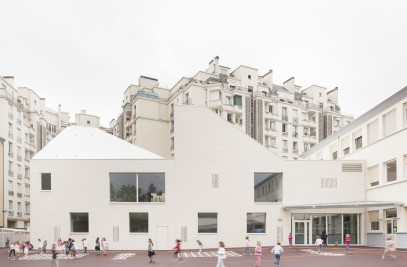A competition to redevelop the ‘Grand Parquet’, a 25-hectare site for equestrian eventing at the heart of the forest of Fontainebleau, France.To design a grandstand and spectator seating, accommodate a new restaurant, an administrative area and competition event facilities, additional stabling and spaces fortemporary horseboxes for visiting competitors, parking.
The forest of Fontainebleau, 60km south of Paris, is a remarkable expanse of 25,000 hectares of mixed deciduous and pine forest and sandy heathland peppered with extraordinary rock formations. Considered to be one of the most beautiful forests in Europe, it is a very popular destination for walkers and climbers.
This exceptional location coupled with the very particular requirements of an eventing arena provided the inspiration for a project that desires almost to disappear into its surroundings.
The existing site has been ‘gently’ re-landscaped, blurring its edges with the surrounding forest. A key element of the new project design is the creation of a pedestrian walkwaythat invites the visitor to explore the site.The path forms a loop around the venue taking in highlights of the grand parquet course and offering views of the forest setting before gently climbing up onto the roof of the grandstand where a large boardwalk area offers visitors abreathtaking panorama of the arena below. This path draws a symbolic line around the competition arena (sand and grass), grouping them together at the heart of the venue.
This is the most visible part of the project’s overriding aim to more logically organize and define the various areas of the site. Visitors and competitors are directed around the venue in a way that creates plenty of opportunity for visual encounterwhilst keeping access routes for pedestrians, vehicles and riders separate wherever possible.
The new building on this site has also been designed with the landscape in mind. Its shape is low and sloped, a continuation of the grassy bank that marks the edge of the grass arena.
On the north side, the building is a grandstand, with simple wooden terraces for seating stepping down towards the arena below. In the centre, a glazed room for event competition officials projects forward, giving judges a privileged view.
From the south side the building presents a giant sloping trellis of wood and climbing plants, a screen that has the visual objective of bedding the building into the landscape and the functional aim of providing natural seasonal solar shading for the building behind.
This south side houses the three ‘functional’ areas requested by the project brief.These are: 1-A public area comprising restaurant, kitchen and public toilets; 2-An area for competition event officials and organizers (meeting rooms, judges area, press room); 3-Grand Parquet administrative/management offices and workshop
In the interests of simplicity, accessibility and legibility, the three functional areas are kept separate. They are physically divided from one another by open passageways running through the building, giving access from the entrance on the south side to the stands to the north. At the same time, they are visually joined by the continuous wall of trellis and the covered walkway this creates along the length of the south side of the building.
The use of materials is fundamental to the blurring of building and landscape. Wood dominates. Wooden decking and slatted boarding constitute the main material for the building, and wood punctuates the ‘Grand Parquet’ landscape in the form of tiered seating, footbridges, terracing and steps, and boardwalk.The wooden terraced seating for spectators continues beyond the confines of the covered grandstand, a strong horizontal presence hugging the curves of the main arena, diminishing gradually the further it progresses.
Elsewhere on the site, the location of permanent stable blocks has been rationalized to align it with the existing perimeter wall and the large areas of hard standing to accommodate visiting competitors horse boxes have been interspersed with pockets of woodland like those of the surrounding forest.
ENVIRONMENTALLY SUSTAINABLE TECHNICAL SOLUTIONS - Re-use of excavated material to create terraced areas - Installation of stormwater infiltration basins - Off-site prefabrication of structural frame for main building, to hold pre-fabricated standardised panels wood/glass - Choice of naturally durable woods for structure, boarding and floor/decking. Interior structure : White spruce glued laminate / Exterior structure : Larch glued laminate / Decking and risers: black locust wood, (naturally class 4 equivalent, untreated) / Boarding : Larch (naturally class 3 equivalent, untreated) / Exterior woodwork: Larch. - Use of planted trellis as solar protection for south facing façade. The design of the screen and the choice of plants (evergreen or deciduous) creates natural solar shading in summer and allows the penetration of sunshine in winter. - Summer temperature control : Use of thermal inertia and a double skin ventilated façade (tiered seating on the roof and façade) to keep the building cool in summer, with additional natural ventilation - Installation of a geothermal heat pump (3100ml) over an area of 1550m2, plus a heat pump water/water to power reversible underfloor heating - Installation of energy recovery ventilation - Good insulation - Building climate control system - Motion and light detection controlled lighting

































